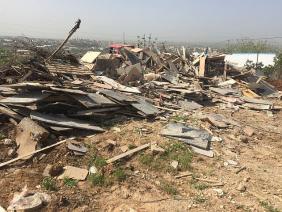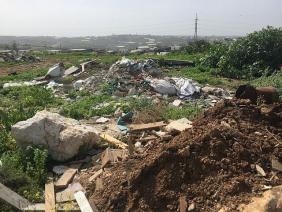Falamiya North Checkpoint (914), Falamiya South Checkpoint (935)
Falamiya North – the gate opened at 06:09. About 100 laborers exit in the morning.
Most of those heading to work in their fields today grow za’atar, instead citrus as in the past. The work is intensive and requires many hands. They market the produce to countries in the region, from Jordan to Saudi Arabia. They arrive at the gate and go through with tractors, bicycles and also on foot. There were no complaints, other than the constant one: laborers who come to work for a short time aren’t able to return until the gate opens in the afternoon and must waste a lot of time. They also spoke about the teachers’ strike, about which they are very annoyed. It’s already in its fifth week and the positions of both sides are becoming more extreme. We spoke for a long time with a pensioner, a former teacher, so were late getting to Falamiya South.
Falamya South – We arrived slightly before the gate was to close. We met two Norwegian volunteers working with Abu Azzam, who had come for two weeks to arrange future contingents.
Jayyous South – It was closed.
‘Azzun – The food chain to the second-hand store doesn’t end there. Unsold items are returned to us and we pass them on to the Bedouin tribe living on the Israeli side of the seam zone. Occasionally we bring them bags of clothing and hope they have need of them. This time a shepherd from Ramadin came to the “distribution point” and invited us to his home. That’s how we were able to meet a Bedouin family which has lived in Ramadin for many years. He says the tribe originally came from the Beersheba and Dahariyya area where they had hundreds of dunams of land, sheep and goats, and were expelled in 1948. In the ‘50s they settled in Ramadin, in the Habla area. They bought the land from its previous owner, who lives in Habla, and they have a tabu [land registry] on the land. They live in sheds, tin shacks and tents.
About two years ago the Civil Administration announced a plan to evacuate them. “Officers of the Civil Administration appeared and presented us with two evacuation proposals. We told them: there are two alternatives. One: we’ll leave if we’re allowed to return to our land in Beersheba and Dahariyya. The other: leave us here and shoot us in the head.” Since then, the Civil Administration hasn’t returned… The village has about 350 inhabitants, almost all of them members of a single extended family. They take care of their homes, but much of the public area is strewn with piles of construction waste, which he says were dumped from Israel four years ago. They use some of the material for building and as heating fuel.
announced a plan to evacuate them. “Officers of the Civil Administration appeared and presented us with two evacuation proposals. We told them: there are two alternatives. One: we’ll leave if we’re allowed to return to our land in Beersheba and Dahariyya. The other: leave us here and shoot us in the head.” Since then, the Civil Administration hasn’t returned… The village has about 350 inhabitants, almost all of them members of a single extended family. They take care of their homes, but much of the public area is strewn with piles of construction waste, which he says were dumped from Israel four years ago. They use some of the material for building and as heating fuel.
We met his four daughters-in-law, young women who are currently raising small children. Two with whom we spoke are university graduates. One is an English teacher and the other a math teacher. One told us she plans to start a kindergarten. She mobilized us (entirely at her own initiative) to help provide materials for the kindergarten: chairs, tables and a blackboard.
So: if anyone has such materials, or games, toys, etc., they’re invited to give them to us.


